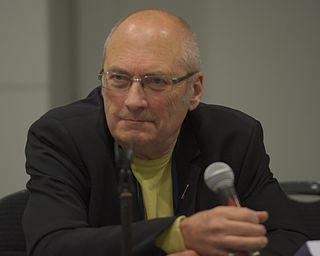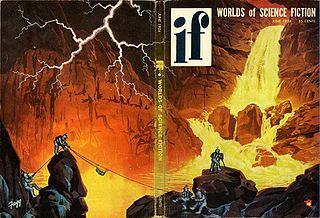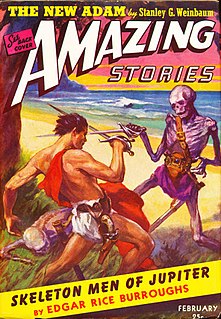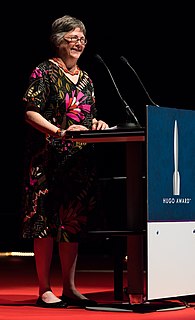Mars, the fourth planet from the Sun, has appeared as a setting in works of fiction since at least the mid-1600s. It became the most popular celestial object in fiction in the late 1800s as the Moon was evidently lifeless. At the time, the predominant genre depicting Mars was utopian fiction. Contemporaneously, the mistaken belief that there are canals on Mars emerged and made its way into fiction. The War of the Worlds, H. G. Wells' story of an alien invasion of Earth by sinister Martians, was published in 1897 and went on to have a large influence on the science fiction genre. Life on Mars appeared frequently in fiction throughout the first half of the 1900s. Apart from enlightened as in the utopian works from the turn of the century or evil as in the works inspired by Wells, intelligent and human-like Martians also began to be depicted as decadent, a portrayal that was popularized by Edgar Rice Burroughs in the Barsoom series. Besides these, more exotic lifeforms appeared in stories like Stanley G. Weinbaum's "A Martian Odyssey". The theme of colonizing Mars replaced stories about native inhabitants of the planet in the second half of the 1900s following emerging evidence of the planet being inhospitable to life, eventually confirmed by data from Mars exploration probes. Terraforming Mars to enable human habitation has been another major theme, especially since the 1990s. Stories of the first human mission to Mars appeared throughout the 1990s in response to the Space Exploration Initiative. The moons of Mars—Phobos and Deimos—have made only sporadic appearances in fiction.

Sword and sorcery (S&S) is a subgenre of fantasy characterized by sword-wielding heroes engaged in exciting and violent adventures. Elements of romance, magic, and the supernatural are also often present. Unlike works of high fantasy, the tales, though dramatic, focus on personal battles rather than world-endangering matters. Sword and sorcery commonly overlaps with heroic fantasy.

Charles Sheffield was an English-born mathematician, physicist and science fiction writer who served as a President of the Science Fiction and Fantasy Writers of America and of the American Astronautical Society.

Gordon Rupert Dickson was a Canadian-American science fiction writer. He was inducted into the Science Fiction and Fantasy Hall of Fame in 2000.
In American science fiction, psionics was a proposed discipline that applied principles of engineering to the study of paranormal or psychic phenomena, such as telepathy and psychokinesis. The term is a portmanteau formed from psi and the -onics from electronics. The word "psionics" began as, and always remained, a term of art within the science fiction community and—despite the promotional efforts of editor John W. Campbell, Jr—it never achieved general currency, even among academic parapsychologists. In the years after the term was coined in 1951, it became increasingly evident that no scientific evidence supports the existence of "psionic" abilities.

Nancy Anne Kress is an American science fiction writer. She began writing in 1976 but has achieved her greatest notice since the publication of her Hugo- and Nebula-winning 1991 novella Beggars in Spain, which became a novel in 1993. She also won the Nebula Award for Best Novella in 2013 for After the Fall, Before the Fall, During the Fall, and in 2015 for Yesterday's Kin. In addition to her novels, Kress has written numerous short stories and is a regular columnist for Writer's Digest. She is a regular at Clarion writing workshops. During the winter of 2008/09, Nancy Kress was the Picador Guest Professor for Literature at the University of Leipzig's Institute for American Studies in Leipzig, Germany.

John Frederick Clute is a Canadian-born author and critic specializing in science fiction and fantasy literature who has lived in both England and the United States since 1969. He has been described as "an integral part of science fiction's history" and "perhaps the foremost reader-critic of sf in our time, and one of the best the genre has ever known." He was one of eight people who founded the English magazine Interzone in 1982.
Michael Lawson Bishop is an American writer. Over four decades and in more than thirty books, he has created what has been called a "body of work that stands among the most admired and influential in modern science fiction and fantasy literature."

Fictional depictions of Mercury, the innermost planet of the Solar System, have gone through three distinct phases. Before much was known about the planet, it received scant attention. Later, when it was incorrectly believed that it was tidally locked with the Sun creating a permanent dayside and nightside, stories mainly focused on the conditions of the two sides and the narrow region of permanent twilight between. Since that misconception was dispelled in 1965, the planet has again received less attention from fiction writers, and stories have largely concentrated on the harsh environmental conditions that come from the planet's proximity to the Sun.

Jupiter, the largest planet in the Solar System, has appeared in works of fiction across several centuries. The way the planet has been depicted has evolved as more has become known about its composition; it was initially portrayed as being entirely solid, later as having a high-pressure atmosphere with a solid surface underneath, and finally as being entirely gaseous. It was a popular setting during the pulp era of science fiction. Life on the planet has variously been depicted as identical to humans, larger versions of humans, and non-human. Non-human life on Jupiter has been portrayed as primitive in some works and more advanced than humans in others.
Saturn has made appearances in fiction since the 1752 novel Micromégas by Voltaire. In many of these works, the planet is inhabited by aliens that are usually portrayed as being more advanced than humans. The planet is occasionally visited by humans and its rings are sometimes mined for resources. The moons of Saturn have been depicted in a large number of stories, especially Titan with its Earth-like environment suggesting the possibility of colonization by humans and alien lifeforms living there.
Uranus was discovered in 1781 and has comparatively rarely been featured in fiction since then. The earliest such works, such as Stanley G. Weinbaum's 1935 short story "The Planet of Doubt" and Clifton B. Kruse's 1936 short story "Code of the Spaceways", portray it as having a solid surface; in the former, humans landing on Uranus encounter hostile aliens. Later works depict it more accurately as a gaseous planet; for instance, Cecelia Holland's 1976 novel Floating Worlds depicts floating cities in the Uranian atmosphere. Towards the end of the 20th century, there was a slight uptick in appearances by Uranus in science fiction, including the 1985 short story "Dies Irae" by Charles Sheffield about life in the atmosphere and the 1999 short story "Into the Blue Abyss" by Geoffrey A. Landis where there is life in the ocean below.

Lisa Gracia Tuttle is an American-born science fiction, fantasy, and horror author. She has published more than a dozen novels, seven short story collections, and several non-fiction titles, including a reference book on feminism, Encyclopedia of Feminism (1986). She has also edited several anthologies and reviewed books for various publications. She has been living in the United Kingdom since 1981.

There have been many attempts at defining science fiction. This is a list of definitions that have been offered by authors, editors, critics and fans over the years since science fiction became a genre. Definitions of related terms such as "science fantasy", "speculative fiction", and "fabulation" are included where they are intended as definitions of aspects of science fiction or because they illuminate related definitions—see e.g. Robert Scholes's definitions of "fabulation" and "structural fabulation" below. Some definitions of sub-types of science fiction are included, too; for example see David Ketterer's definition of "philosophically-oriented science fiction". In addition, some definitions are included that define, for example, a science fiction story, rather than science fiction itself, since these also illuminate an underlying definition of science fiction.
Black holes, objects whose gravity is so strong that nothing including light can escape them, have been depicted in fiction since before the term was coined by John Archibald Wheeler in the late 1960s. The earliest stories featuring what would later be called black holes, such as E. E. Smith's 1928 story The Skylark of Space and its "black sun", typically portrayed them as hazards to spacefarers. Later works such as the 1975 Space: 1999 episode "Black Sun" have occasionally done likewise, and a few have even depicted black holes being outright weaponized, one example being the 1982 novel The Space Eater by David Langford.
Paul le Page Barnett, known by the pen name of John Grant, was a Scottish writer and editor of science fiction, fantasy, and non-fiction.

Immortality is a common theme in fiction. The concept has been depicted since the Epic of Gilgamesh, the oldest known work of fiction. Originally appearing in the domain of mythology, it has later become a recurring element in the genres of horror, science fiction, and fantasy. For most of literary history, the dominant perspective has been that the desire for immortality is misguided, albeit strong; among the posited drawbacks are ennui, loneliness, and social stagnation. This view was challenged in the 20th century by writers such as George Bernard Shaw and Roger Zelazny. Immortality is commonly obtained either from supernatural entities or objects such as the Fountain of Youth or through biological or technological means such as brain transplants.
Supernovae have been featured in works of fiction. While a nova is strictly speaking a different type of astronomical event, science fiction writers often use the terms interchangeably and refer to stars "going nova" without further clarification; this can at least partially be explained by the earliest science fiction works featuring these phenomena predating the introduction of the term "supernova" as a separate class of event in 1934. Since these stellar explosions release enormous amounts of energy, some stories propose using them as a power source for extremely energy-intense processes, such as time travel in the Doctor Who serial The Three Doctors from 1972. For the same reason, inducing them is occasionally portrayed as a potential weapon, for instance in the 1966 novel The Solarians by Norman Spinrad.

Two Complete Science-Adventure Books was an American pulp science fiction magazine, published by Fiction House, which lasted for eleven issues between 1950 and 1954 as a companion to Planet Stories. Each issue carried two novels or long novellas. It was initially intended to carry only reprints, but soon began to publish original stories. Contributors included Isaac Asimov, Robert A. Heinlein, Arthur C. Clarke, Poul Anderson, John Brunner, and James Blish. The magazine folded in 1954, almost at the end of the pulp era.

Voodoo Planet is a science fiction novel by American writer Andre Norton, first published in 1959 by Ace Books. This is a short novel that was usually published in a double-novel format. It is part of the Solar Queen series of novels.











